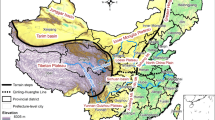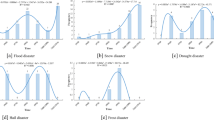Abstract
Frost stress is a major environmental factor that limits apricot growth in the warm temperate zone (WTZ) of China, and is always triggered by extreme low temperature weather processes. In this study, the characteristics of the apricot frost processes f(D, Tcum), which were identified from historical disaster representation, were analyzed and apricot frost evaluation indicators were developed, thus facilitating the process-based assessment and spatiotemporal analysis of apricot frost processes. Periods of low temperature that persist for 1~2, 3, and ≥4 days (i.e., duration days, D) provide the initial identification indicator for light, moderate, and severe apricot frost. The threshold ranges for Tcum are 0~3.9, 9.2~12.0, and >16.2 for D values of 1~2, 3, and ≥4, respectively. The northwest of the WTZ is dominated by apricot frost, with approximately 80% of apricot frost being light, followed by moderate and severe. Regional apricot frost exhibited a significant decreasing trend over the last four decades. A total of 29.65% of stations, which were mainly located in the northwest and middle parts of the study region, detected an increasing trend in apricot frost. The results provide technical support for targeted apricot frost level detection, and the process-based spatiotemporal characteristics of apricot frost can provide basic information for the prevention and mitigation of apricot frost.







Similar content being viewed by others
Data availability
Data available on request from the authors.
References
Ana M, Petrović Slavoljub S, Dragićević Boris P, Radić Ana Z, Milanović P (2015) Historical torrential flood events in the Kolubara river basin. Nat Hazards 79(1):1–11
Augspurger CK (2013) Reconstructing patterns of temperature, phenology, and frost damage over 124 years: spring damage risk is increasing. Ecology 94:41–50
Ballard JK, Proebsting EL, Tukey RB (1997) Critical temperatures for blossom buds, cherries. Extension bulletin no. 1128. Washington State University, Pullman
Bao FP (2011) Selected papers of Fu Baopu. Meteorological Press, Beijing ((In Chinese))
Booth TH (1990) Mapping regions climatically suitable for particular tree species at the global scale. Forest Ecol Manag 36:47–60. https://doi.org/10.1016/0378-1127(90)90063-H
Chuine I, Cour P (1999) Climatic determinants of budburst seasonality in four temperate-zone tree species. New Phytol 143(2):339–349
Ding T, Gao H, Li X (2021) Increasing occurrence of extreme cold surges in North China during the recent global warming slowdown and the possible linkage to the extreme pressure rises over Siberia. Atmos Res 248:105198
Ding YH, Krishnamurti TN (1987) Heat budget of the Siberian high and the winter monsoon. Mon Weather Rev 115:2428–2449
Erez A, Lavee S, Samish RM (1971) Improving methods for breaking rest in the peach and other deciduous fruit species. J Am Soc Hortic Sci 96:519–522
Fernández-Long ME, Müller GV, Beltrán-Przekurat A, Scarpati OE (2013) Long-term and recent changes in temperature-based agroclimatic indices in Argentina. Int J Climatol 33:1673–1686
Friday F, Monday M (1974) Theory of probability and mathematical statistics. Am Math Soc 2:223–224
Gu L, Hanson PJ, Post WM, Kaiser DP, Yang B, Nemani R, Pallardy SG, Meyers T (2008) The 2007 eastern US spring freeze: increased cold damage in a warming world? AIBS Bull 58:253–262
Hatice D, Veli E, Ali K, Said ED, Rabia AD, Zahide K, Cemil E, Tahir M, Bakir M (2019) Spring late frost resistance of selected wild apricot genotypes (Prunus armeniaca L.) from Cappadocia region, Turkey. Sci Horticulturae 246:347–353
Hue DT, Götz KP, Chmielewski FM (2016) Yield formation of sweet cherry cultivar ‘Summit’. DACH-meteorological conference, 14–18 March 2016, abstract book:45, Berlin
Huo Z, Mao H, Yang J, Wang P, Wu D, Ma Y (2022) Process-based evaluation indicators of grape drought and risk characteristics in the Bohai Rim Region, China. Theor Appl Climatol. https://doi.org/10.1007/s00704-022-04251-w
Jena PP, Chatterjee C, Pradhan G, Mishra A (2014) Are recent frequent high floods in Mahanadi basin in eastern India due to increase in extreme rainfalls? J. Hydrol 517(1):847–862
Kellison R C, Lea R, Marsh P (2013) Introduction of Eucalyptus spp. into the United States with special emphasis on the Southern United States. Int J Forest Res https://doi.org/10.1155/2013/189393
Lang GA, Early JD, Martin CG, Darnel RL (1987) Endo-para-, and ecodormancy: physiological terminology and classification for dormancy research. Hortic Sci 22:371–377
Lauren P, Tapan P, Steven O (2021) Climate change reduces frost exposure for high-value California orchard crops. Sci Total Environ 762:143971
Matzneller P, Götz KP, Chmielewski FM (2016) Spring frost vulnerability of sweet cherries under controlled conditions. Int J Biometeorol 60:123–130. https://doi.org/10.1007/s00484-015-1010-1
Ng S, Wood SH, Ziegler AD (2015) Ancient floods, modern hazards: the Ping River, paleofloods and the ‘lost city’ of Wiang Kum Kam. Nat Hazards 75:2247–2263
Ozkan K, Cafer K, Tevhit G (2018) An exothermic process involved in the late spring frost injury to flower buds of some apricot cultivars (Prunus armenica L.). Sci Hortic 241:322–328
Proebsting EL (1982) Cold resistance of stone fruit flower buds. Cooperative Extension of Washington State University, Washington
Rigby JR, Porporato A (2008) Spring frost risk in a changing climate. Geophys Res Lett 35:L12703
Robeson SM (2002) Increasing growing-season length in Illinois during the 20th century. Clim Change 52:219–238
Susan M, Kotikota AF, Robert EG, Absae S, James N, Robinson M, Ashutosh L, Daniel EI (2018) Mapping threats to agriculture in East Africa: performance of MODIS derived LST for frost identification in Kenya’s tea plantations. Int J Appl Earth Obs Geoinf 72:131–139
Tao FL, Xiao DP, Zhang S, Zhang Z, Rotter RP (2017) Wheat yield benefited from increases in minimum temperature in the Huang-Huai-Hai Plain of China in the past three decades. Agric for Meteorol 239:1–14
University of California, Agriculture and Natural Resources (UCANR) (2023). Avocado handbook. https://iwp.ucanr.edu/countyoffice/science-based-solutions-ventura-countys-communities-farms-and-environment/avocado-handbook
Vitasse Y, Lenz A, Koerner C (2014) The interaction between freezing tolerance and phenology in temperate deciduous trees. Front Plant Sci 5(541):1–12
Vitasse Y, Schneider L, Rixen C, Christen D, Rebetez M (2018) Increase in the risk of exposure of forest and fruit trees to spring frosts at higher elevations in Switzerland over the last four decades. Agric For Meteorol 248:60–69
Viti R, Bartolini S, Andreini L (2010) Flower bud frost tolerance of several Italian apricot genotypes. Eur J Hortic Sci 75(5):185–192
Wang ZB, Chen J, Tong WJ, Xu CC, Chen F (2018) Impacts of climate change and varietal replacement on winter wheat phenology in the North China plain. Int J Plant Prod 12:251–263
Wang PJ, Huo ZG, Yang JY, Wu X (2019) Indicators of chilling damage for spring maize based on heat index in Northeast China. J Appl Meteorol Sci 30(1):13–24 (Chinese with English abstract)
Wang S, Chen J, Rao Y, Liu L, Wang W, Dong Q (2020) Response of winter wheat to spring frost from a remote sensing perspective: damage estimation and influential factors. ISPRS J Photogramm Remote Sens 168:221–235
Wang P, Tang J, Ma Y, Wu D, Yang J, Jin Z, Huo Z (2021a) Mapping threats of spring frost damage to tea plants using satellite-based minimum temperature estimation in China. Remote Sens 13:2713. https://doi.org/10.3390/rs13142713
Wang PJ, Ma YP, Tang JX, Wu DR, Chen H, Jin ZF, Huo ZG (2021b) Spring frost damage to tea plants can be identified with daily minimum air temperatures estimated by MODIS land surface temperature products. Remote Sens 13:1177
WAPA (2018) European Apple and Pear Crop Forecast. World Appel and Pear Organisation. Brussels, Belgium
Wu X, Wang PJ, Huo ZG, Wu DR, Yang JY (2018) Crop drought identification index for winter wheat based on evapotranspiration in the Huang-Huai-Hai Plain. China Agric Ecosyst Environ 263:18–30
Xiao LJ, Liu LL, Asseng S, Xia YM, Tang L, Liu B, Cao WX, Zhu Y (2018) Estimating spring frost and its impact on yield across winter wheat in China. Agric for Meteorol 260:154–164
Yang JY, Huo ZG, Wu L, Wang T, Zhang G (2016) Indicator-based evaluation of spatiotemporal characteristics of rice flood in Southwest China. Agr Ecosyst Environ 230:221–230
Yang JY, Huo Z, Li X, Wang P, Wu D (2020) Hot weather event based characteristics of double-early rice heat risk: a study of Jiangxi province, South China. Ecol Indic 113:106148
Yang J, Huo Z, Wang P, Wu D, Ma Y, Yao S, Dong H (2021) Process-based indicators for timely identification of apricot frost disaster on the warm temperate zone. China. Theor Appl Climatol. https://doi.org/10.1007/s00704-021-03762-2
Yang J, Dong H, Huo Z, Wang P, Yao S, Wu D, Ma Y (2022) Threshold-based characteristics of apricot frost exposure at young fruit in the warm temperate zone, China. Int J Climatol 42(3):1460–1471
Yann V, Léonard S, Christian R, Danilo C, Martine R (2018) Increase in the risk of exposure of forest and fruit trees to spring frosts at higher elevations in Switzerland over the last four decades. Agric for Meteorol 248:60–69er 124 years: spring damage risk is increasing. Ecology 94:41–50
Yin LF, Cai ML, Du SF, Luo CX (2017) Identification of two Monilia species from apricot in China. J Integr Agric 16(11):2496–2503
Yue Y, Zhou Y, Wang J, Ye X (2016) Assessing wheat frost risk with the support of GIS: an approach coupling a growing season meteorological index and a hybrid fuzzy neural network model. Sustainability 8(12):1308
Zhang JY, Zhang Z (2003) Chinese fruit tree (Apricot). China Forestry Publish, Beijing
Acknowledgements
We gratefully acknowledge the anonymous reviewers for their valuable comments on the manuscript.
Funding
This research was supported by the National Key R&D Program of China (2019YFD1002203) and the Basic Research Fund of Chinese Academy of Meteorological Sciences (2023Z014).
Author information
Authors and Affiliations
Corresponding author
Ethics declarations
Conflict of interest
The authors declare that they have no known competing financial interests or personal relationships that could have appeared to influence the work reported in this paper.
Additional information
Author Lei Zhang contributed to the work equally and should be regarded as co-first authors.
Rights and permissions
Springer Nature or its licensor (e.g. a society or other partner) holds exclusive rights to this article under a publishing agreement with the author(s) or other rightsholder(s); author self-archiving of the accepted manuscript version of this article is solely governed by the terms of such publishing agreement and applicable law.
About this article
Cite this article
Yang, J., Zhang, L., Huo, Z. et al. Disaster process–based spatiotemporal characteristics of apricot frost in the warm temperate zone (WTZ), China. Int J Biometeorol 67, 1733–1744 (2023). https://doi.org/10.1007/s00484-023-02534-z
Received:
Revised:
Accepted:
Published:
Issue Date:
DOI: https://doi.org/10.1007/s00484-023-02534-z




